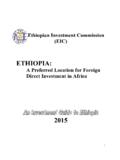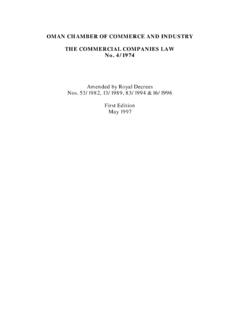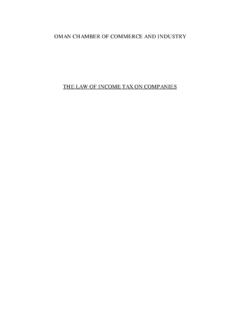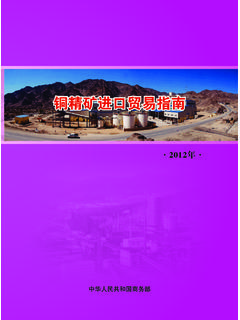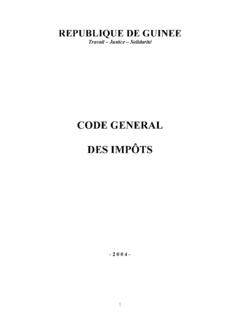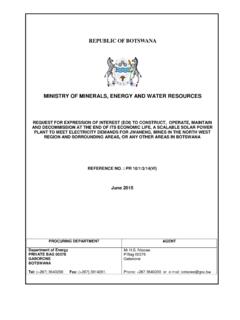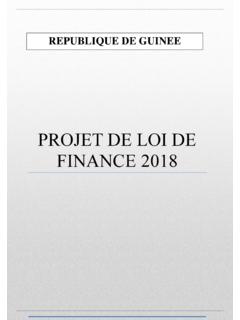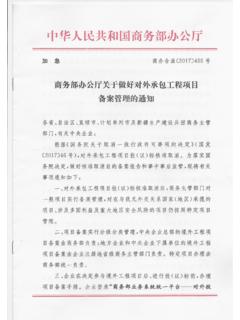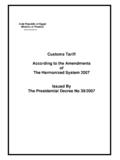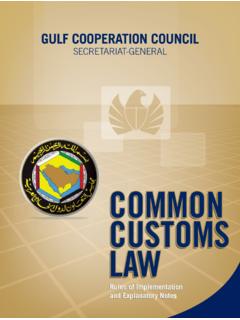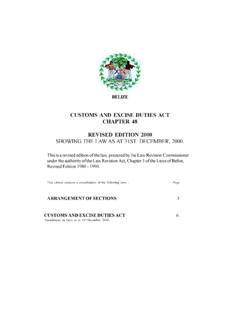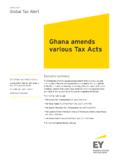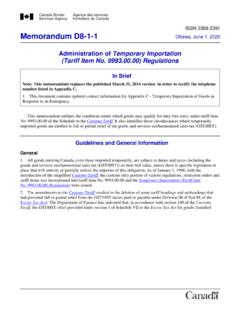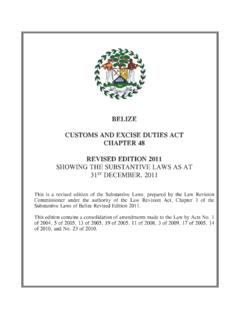Transcription of The Russian Federation - MOFCOM
1 Foreign Market Access Report 2010 1 The Russian Federation [Risk Warning] Russia applies mandatory certification to imported products such as foodstuffs, household electrical appliances, electronics, cosmetics, furniture, toys and ceramics. Russia does not recognize the relevant international standards, and all imported products must be GOST-certified before they are allowed to enter the Russian market. The Russian mandatory certification standards are multifarious and complicated, 70% of which are not in line with corresponding international standards, and its safety standards in certain areas are higher than those of many developed countries. The relevant Chinese enterprises exporting to Russia should pay close attention to the laws and regulations regarding product certification. Since May, 2006, Russia has raised its export tariff on logs many times.
2 Considering the impact of the global financial crisis, Russia has decided to postpone its plan to increase by 2009 its export tariff on logs to 80% so as to promote its exports. However, Russia s export tariff on logs is expected to rise in 2010 to 80% or 50 euro per cubic meter, whichever is higher. Chinese wood importing enterprises are reminded to keep a close watch on the change of export tariff on logs in Russia and make an appropriate arrangement of their imports in order to reduce import costs. 1 Bilateral Trade and Investment According to the statistics released by China Customs, the total volume of bilateral trade between China and Russia reached US$ billion in 2009, down from the previous year, among which China s exports to Russia amounted to US$ billion, a decrease of , while its imports from Russia came out at US$ billion, down China held a trade deficit of US$ with Russia.
3 China s exports to Russia included mechanical and electronic products, footwear, textile and apparel, leathers, furniture, automobiles, and other products. China mainly imported from Russia mineral fuels, iron and steel, nickel and its products, seafood, wood, and chemicals. According to China s Ministry of Commerce (hereinafter referred to as MOFCOM ), in 2009, the turnover of engineering contracts completed by Chinese companies in Russia reached US$ 884 million, and the volume of newly signed contracts arrived at US$ billion. The volume of completed labor service contracts ran into US$ 115 million, and the volume of newly signed contracts stood at US$ 114 million. China s total non-financial investment in Russia, approved by or filed with MOFCOM , reached US$ 413 million in 2009. According to MOFCOM , Russian investors invested in 94 projects in China in 2009, with a contractual volume of US$ 179 million and an actual utilization of US$ million.
4 Foreign Market Access Report 2010 22 Russia s Trade and Investment Regime Trade Administration Regime and Its Developments In order to apply for a membership in the World Trade Organization (WTO), Russia decided to join the WTO as part of a unified customs territory with neighbors Belarus and Kazakhstan. In August, 2009, Russia, Belarus and Kazakhstan formally set up a unified working party for WTO accession negotiations, planning to restart its accession bid. Russia s laws and regulations related to trade administration consist mainly of the Law on State Adjustment of Foreign Economic Activity, the Customs Code of the Russian Federation , the Law on Adjustment of Technology, the Federal Law on Special Safeguard, Anti-dumping and Countervailing Measures Against Imports, the Law on Adjustment and Surveillance of Foreign Exchange, and the Law on the Measures Protecting State Economic Interests in Foreign Trade.
5 Other principal laws and regulations include the Law on Lease, the Law on the Certification of Goods and Services, the Law on Goods Identification, Services Identification and Naming Origins of Goods, the Law on Export Surveillance, the Federal Guidance on Export Development, the Directory of Federal Tariff Code and Foreign Trade Commodities, the Federal Law on Franchising, the Law on Electronic and Digital Signature, the Regulation on the Surveillance of Exports of Dual-use Goods and Technologies from the Russian Federation , the Regulation on the Licensing System for Foreign Trade in Commodities and on the Incorporation of Licensed Banks, the Regulation on the Import and Export of Pharmaceuticals, and the Regulation on Supervision over Customs Houses in Respect of the Implementation of the Relevant Laws on the Calculation and Collection of Customs Duties and on the Determination of Customs Values.
6 In 2009, the Russian State Duma, the lower house of the Federal Assembly of Russia, set up a special Law Revision Commission, examined and revised the draft amendments to the Law on State Adjustment of Foreign Economic Activity submitted by the Russian government, and put forward new suggestions on the draft amendments. Tariff Regime Generally, ad valorem duties apply to the imports in Russia, while specific duties or compound duties apply to approximately 10% of the imports including clothing, shoes and hats, luggage, plastic products, phonograph records, video cassettes, and certain electrical home appliances. Currently, Russia s ad valorem duty rates are divided into five levels: 0%, 5%, 10%, 15% and 20%, with a weighted average tariff rate of According to the Russian Tariff Schedule, Russia levies the most-favored-nation (MFN) tariff rate on imports from countries accorded MFN status, but imports from other non-MFN countries are subject to a tariff rate twice as high as the MFN rate.
7 Imports from countries under the Generalized System of Preferences (GSP) scheme, least developed countries (LDCs), and members of the Commonwealth of Independent States (CIS) that have signed free trade agreements with Russia enjoy preferential customs duties. Specifically, imports from CIS members which have entered into free trade agreements with Russia and LDCs are exempt from Foreign Market Access Report 2010 3import customs duties, and imports from GSP countries are subject to customs duties at 75% of the MFN tariff rate. According to the Basic Guidelines for Customs Policy for 2008-2010 approved in 2007, Russia has been gradually lowering import customs duties on certain specific goods, including offshore drilling rigs, nuclear reactor facilities, aircraft parts, flight simulators for civil aviation, medical instruments, metalworking equipments, audio equipments and digital cameras, mobile phone batteries, and child safety seats.
8 Russia is planning to cut the average customs duties on imports from down to by the end of 2010, among which industrial goods will enjoy the biggest cut in customs duties (from 10% to ), while agricultural products will have the smallest cut (from to 18%). After removing import customs duties on goods such as coke, polyethylene (PE), tea, certain pelts in the rough, raw materials and equipment for making spectacle frames, digital cameras, liquid crystal displays (LCD) and plasma screen displays, and lowering import customs duties on goods such as garments and hats in 2008, Russia again decreased import customs duties on some specific imports in 2009. According to government decree No. 329 of April 15, 2009, Russia decided to extend for a period of 9 months its zero-tariff policy on child car safety seats. On November 14, 2009, the Russian Prime Minister Vladimir Putin signed government decree No.
9 931, prolonging its zero tariff rate on specific types of high-speed electromotive carriages ( Russian customs code numbers 8605 00 00 1 and 8603 10 00 1) for 9 months. On November 11, 2009, the Russian Prime Minister signed government decree No. 933, temporarily lowering the import customs duties on non-plastic spectacle frame parts from 15% to 0% for 9 months. According to government decree No. 936, Russia has eliminated its import customs duties on natural rubbers, technically classified natural rubbers (customs code number 4001 22 000 0) and other rubbers (customs code number 4001 29 000 0). To stimulate domestic automobile manufacturing, Russia lowered import customs duties on steels of thickness less than mm, width less than 60 cm and nickel content less than , and abolished import customs duties on cold rolled sheets with thickness of mm to mm, effective from 2009.
10 From January 1, 2010, Russia within the unified customs tariff framework of the customs union between Russia, Kazakhstan and Belarus further lowered import customs duties on a wide range of electromechanical goods for daily use: import duties on dishwashers and air conditioners were eliminated; import duties on small household appliances such as vacuum cleaners, blenders, juice extractors, and hair clippers were lowered from 15% to 10%; import duty on microwave ovens was lowered from 20% to 15%; import duties on electrical appliances such as electrical stoves, ovens and toasters were lowered from 15% to 10%; import duties on hair dryers, hand dryers and steam irons were lowered from 15% to 10%; import duties on DVD players and radio receivers were lowered from 10% to 5%, excluding mobile phones, earphones, microphones, stereo systems, micro digital recorders, and U-discs.
